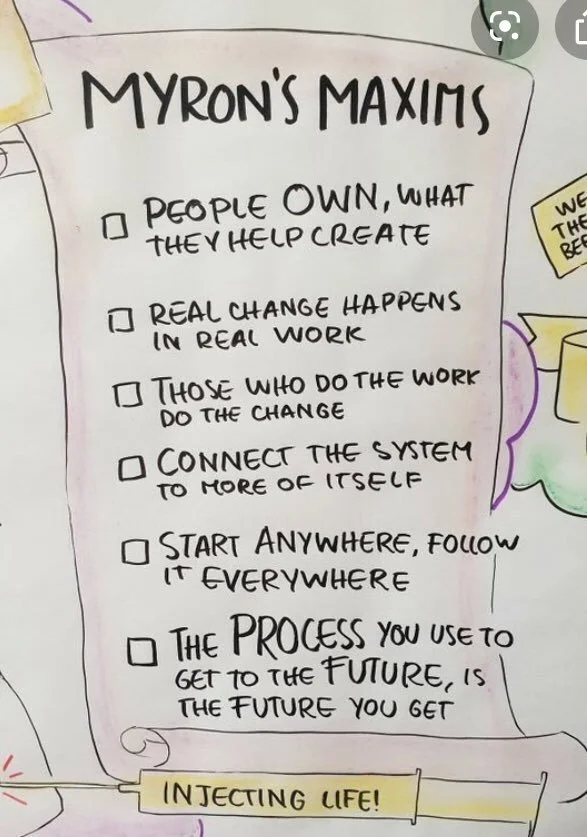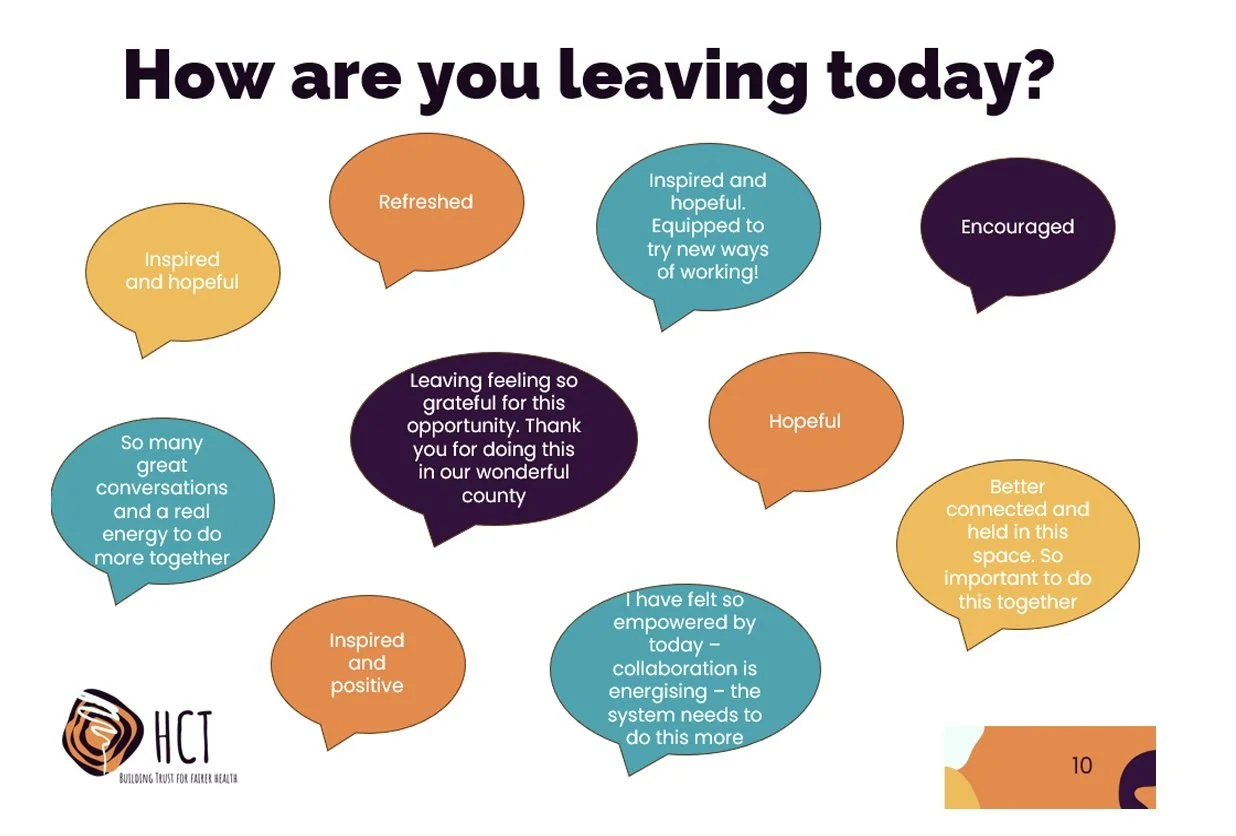What we learnt from our creative conversation about HOW we work together support health and wellbeing,
Healthy Communities Together (HCT) Gloucestershire is a collaborative learning venture about systems partnership, supported by the National Lottery Community Fund and the Kings Fund.
In June 2023 Healthy Communities Together (HCT) Gloucestershire held a Structures of Togetherness Event in Stroud Sub Rooms, a creative conversation about whether HOW we work together in the county to support health and wellbeing, matters as much as WHAT we do (hint: HCT thinks it does).
This article is what we learnt and how that means we will continue to work in HCT. We have summarised our learning below but you can read on for all the detail.
Summary of learning points:
We want to continue to be bold by naming emerging ideas or “hunches” before they are fully formed, fully researched and fully defensible.
We will continue to bring more of the system together with a greater sense of confidence that this generates excitement and generosity and a high level of engagement.
We will be unapologetic about giving this the time people need and want when they truly settle into this way of connecting.
We are learning that how we work together is as important as what we work on together. This event put the emphasis on the ‘how’ over the ‘what’, trusting that they are intertwined, trusting that ‘the process we use to get to the future is the future we will get’.
HCT will continue to model starting well in our events and gatherings. People were willing to go very deep, very quickly, and this generosity of listening led to a palpable sense of a room full of human beings, showing up as themselves. By starting with the human, we felt able to move beyond the contested territory and different agendas held by some and not others.
HCT will continue to be brave about opening and holding space for connection – for its own sake – and knowing that it is both wanted and welcomed. Allowing those who turned up to set the agenda meant we heard what matters to people and formed a deeper and shared understanding in the room of both the challenges and opportunities of collaboration. We can’t control complexity so HCT will continue to ask questions and prioritise learning first and foremost.
This learning will come along with us as we continue to explore the ways we can build the system-wide ‘muscle’ to convene and connect – a regenerative feat rather than a one-off programme. We believe HOW we work alongside each other is important to focus on because initiatives and projects run their course, but connection and trust endure, forming the foundations for deeper and more radical change.
Read on for the full article.
1. Our event was designed to throw a wide net and find out who else in Gloucestershire might be intrigued and curious to explore the skills, behaviours and mindsets needed to work in a radically collaborative way
HCT was set up to test out whether better collaboration might help us to address health inequality in a new and durable way. While Gloucestershire is a relatively healthy county, there are differences in health outcomes that aren’t fair.
We have spoken to numerous people within Gloucestershire and further afield with a similar agenda and who have experience of how collaboration is a key ingredient in sustaining change.
We found a lot of shared thinking in Myron’s Maxims, Collaborate CIC the University of Northumbria on Human Learning Systems, the catalyst programme run by Create Gloucestershire and nowhere and the Stewardship Circle at Barnwood. It felt quite a big step to go public with our emerging ideas - we were nervous that our “sense” might be “non sense” to others! So, we were genuinely bowled over when within the first few days the event was fully booked and we had to upsize to a larger room in the Sub Rooms to include everyone.
We want to continue to be bold in this way by naming emerging ideas or “hunches” before they are fully formed, fully researched and fully defensible.
2. When everyone is so busy how do you get the right people into the room and for long enough?
A key success criterion for the event was to “connect the system to more of itself”- to use one of Myron’s Maxims. We wanted to ensure people could connect with others outside of their usual networks, organisation or sector.
To achieve this, we ring fenced tickets for different parts of the system. We created a flyer which was sent with personal invite emails from the HCT group. We paid attention to getting the right venue – accessible and welcoming in the physical and psychosocial sense – the Sub Rooms in Stroud proved a perfect choice: good location for public transport, spacious and light, helpful staff and (possibly!) the best brownies in Gloucestershire!
An early decision was to publicise Structures of Togetherness as an event for everyone engaged in social change, not as an event for “systems leaders”. By choosing to foreground how we all work together in Gloucestershire we hoped we would include more people and better fit with the change HCT is pushing on – i.e., that everyone needs to be involved in living well and staying healthy. It also honoured the learning from the catalyst programme that the term “leader” can exclude under-represented leaders and/or those who feel our existing model of leadership is part of the problem.
We thought very carefully about who we could ask to contribute to the event and decided against a single “expert” keynote speaker in favour of 6 Lightening Talks.
These were proposed by a fantastic group of change agents who were creative, academic, based in communities or public sector organisations, local and international. We made sure we had enough time to secure these contributors before the flyer was finalised with the hope that everyone would see something of their truth on the invite and feel welcome. Ringfencing invitations, paying attention to the diversity of contributors and approaching people personally worked well... 65 people attended the event with roughly a third from the public sector, a third from the VCSE and a third independents which included funders, writers and academics.
Here’s some things people said as they left:
We will continue to bring more of the system together with a greater sense of confidence that this generates excitement and generosity and a high level of engagement. We will be unapologetic about giving this the time people need and want when they truly settle into this way of connecting.
3. How do you start an event if the HOW is the “real” business?
Against a backdrop of busy diaries and crisis management we wanted Structures of Togetherness to be a worthwhile use of precious time and felt under pressure to achieve this!
We wanted the event to test out what it might be like if relationships and connectivity are placed centre stage. We set up a small co-design team (Pippa Jones, Myron Rogers, Jo Underwood) tasked with setting a different tone for the day, and helping the room to be a responsive, emotionally connected space.
How we started was vital to disrupt conventional wisdom that meetings need to get to the business as quickly as possible and so leave a minimum amount of fuss and time wasting on introductions above and beyond name, job title and organisation.
So, we chose to allocate a good chunk of time to a check-in or connecting conversation. In pairs each person had 3 minutes to answer 3 questions.
What calls you to this work?
Who called you?
Who are you here in service of?
Everyone was prompted by Myron that the quality of their listening would improve the quality of the telling. The 3 minutes was to be solid listening with no questions, or interruptions. After each pair had heard from each other they were to pair up with another and notice any patterns, similarities, themes that might have emerged.
These questions encouraged people to say who they were rather than what their job was. A very human start to the day which created a deeper level of connection, warmth and vulnerability. It helped to remind everyone of who we are in service to, again often invisible in a job title or organisational name.
Good listening was a thread throughout the event, embodied in our two Keynote Listeners who were asked to share what they had heard and noticed – both what was being said and what wasn’t. Who was in the room – who was missing.
We are learning that how we work together is as important as what we work on together. This event put the emphasis on the ‘how’ over the ‘what’, trusting that they are intertwined, trusting that ‘the process we use to get to the future is the future we will get’.
HCT will continue to model starting well in our events and gatherings. People were willing to go very deep, very quickly, and this generosity of listening led to a palpable sense of a room full of human beings, showing up as themselves. By starting with the human, we felt able to move beyond the contested territory and different agendas held by some and not others.
4 How can we avoid a habit of “broadcast” mode in meetings and events that essentially gives all the airtime to pre-fixed ideas and opinions.?
We scheduled time in the day for Open Space- an approach we have used at two other HCT events. At its core Open Space gives those people present agency in what gets discussed.
We love it at HCT because:
It is an exquisite way to devolve power to those in the room and to encourage agency in the way we all show up to conversations that call us,
No single design group – however diverse – could ever predict the range of topics people were called to propose,
It follows the energy in the room at that particular time,
You can’t stage it – what happens is what should have happened
It doesn’t circumnavigate the issues: ‘let’s talk about power’, ‘let’s talk about keeping our promises’.
There’s always a breathless moment of silence as the space opens, believe us when we say it’s a nervous time – but the agenda filled up faster than we could list all the ideas people wanted to spend time talking about.
Similarly coming out of a brief Open Space is always tricky. In its purest sense Open Space can go on for 2 or 3 days, with conversations, ideas and commitments growing out organically from the initial topics. Many didn’t want to leave their conversations and we didn’t really enjoy stopping them. We took that as early signs that the gamble was paying off – people really were relishing the space to connect with people they didn’t usually see, on things that mattered a lot.
The complexity of ideas raised (some specific, some systems wide, some individual some global) made it crystal clear that we must stop pretending that the health systems are biddable, controllable or attributable. And become more competent at how we dance between the very specific and the system, holding the individual part within a picture of the whole.
HCT will continue to be brave about opening and holding space for connection – for its own sake – and knowing that it is both wanted and welcomed. Allowing those who turned up to set the agenda meant we heard what matters to people and formed a deeper and shared understanding in the room of both the challenges and opportunities of collaboration. We can’t control complexity so HCT will continue to ask questions and prioritise learning first and foremost.
This learning will come along with us as we continue to explore the ways we can build the system-wide ‘muscle’ to convene and connect – a regenerative feat rather than a one-off programme. We believe HOW we work alongside each other is important to focus on because initiatives and projects run their course, but connection and trust endure, forming the foundations for deeper and more radical change.
Pippa Jones, Jo Underwood & Myron Rogers





